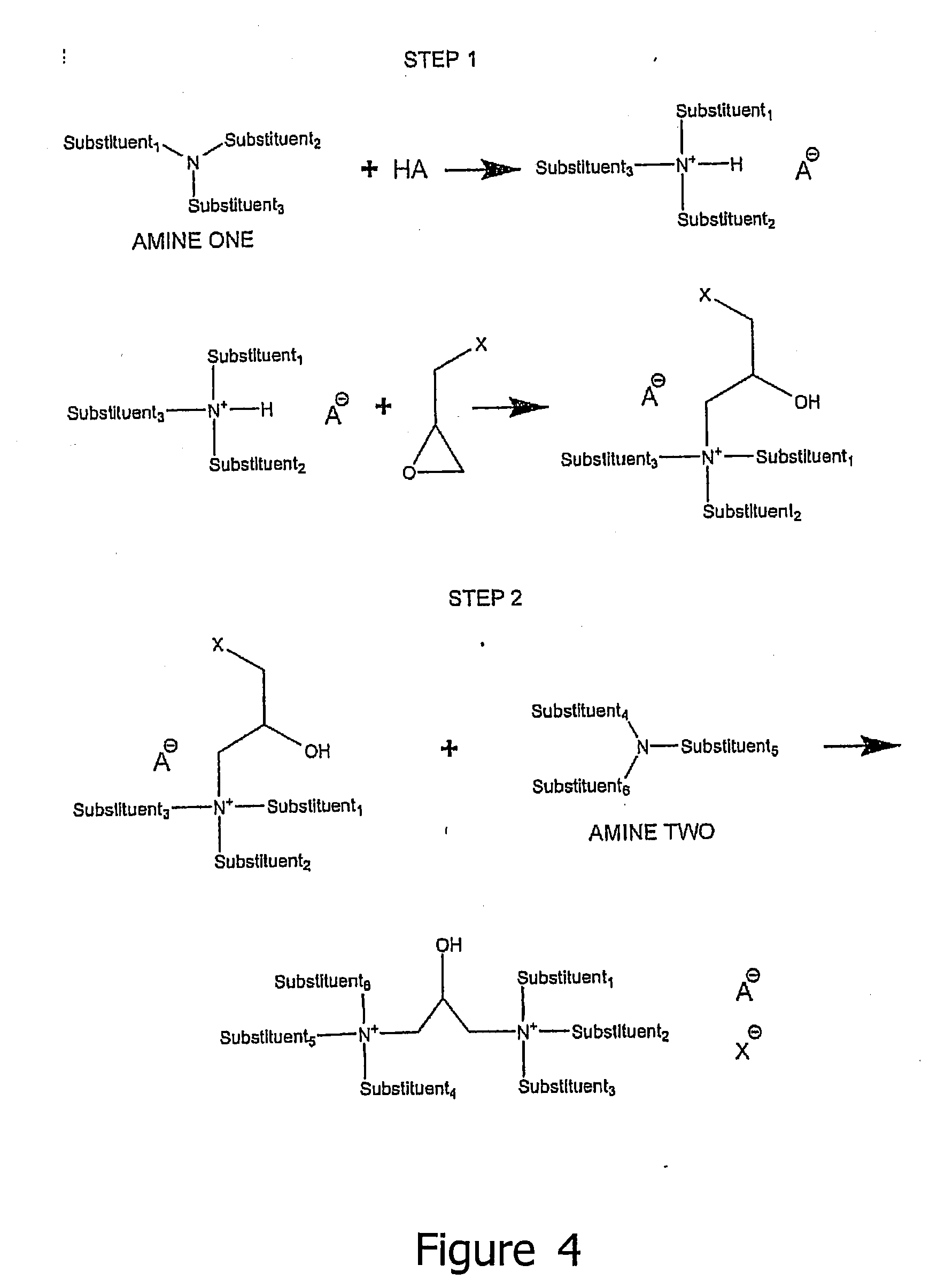Polycationic viscoelastic compositions
a technology of viscoelastic composition and polycationic quaternary ammonium, which is applied in the direction of water softening, other chemical processes, well accessories, etc., can solve the problems of affecting the flow of oil, requiring a significant amount of time and additional well treatment chemicals, and achieving distinct and useful properties
- Summary
- Abstract
- Description
- Claims
- Application Information
AI Technical Summary
Benefits of technology
Problems solved by technology
Method used
Image
Examples
example 1
Synthesis of Structurally Defined SoyAPDMA-3(OH)-18APDMA
[0235]A 1000 ml 5-necked glass flask was charged with about 40 g of deionized (DI) water, about 91.4 g of 2-propanol, 179 g of stearamidopropyldimethylamine (SAPDMA) (482.5 mmol) and 91.8 g of para-toluenesulfonic acid (“PTSA”) dihydrate (482.5 mmol). The mixture was mixed and heated to approximately 50° C. About 46 g (497 mmol) of epichlorohydrin was added to the reactor dropwise during 2 hours with the reactor still at approximately 50° C. The pH value of the reaction mixture changed from about 4.5 (when the addition of epichlorohydrin started) to about 4.85 (when the addition finished).
[0236]After holding the reaction mixture at approximately 50° C. for an additional 2 hours, the pH became 5.17. The temperature of the solution was then increased to approximately 70° C. About 173 g (482.5 mmol) of soyamidopropyldimethylamines (SoyAPDMA) were added dropwise to the reactor. The pH value of the reaction solution was monitored so...
example 2
Synthesis of Symmetric HERAPDMA-GQ
[0239]About 119 g 2-propanol and 177.4 g of high erucic rapeseed amidopropyl-N,N-dimethylamine (HERAPDMA) were added to 1000 ml 5-necked flask. A mixture of about 24.3 g of a solution of 37% HCl by weight and 5.7 g water was added to the flask dropwise over approximately 15 minutes with vigorous stirring and air cooling to minimize heating. At the end of addition, the temperature of solution reached 55° C., and the pH was 7.2. The addition funnel well was rinsed with water, and then epichlorohydrin was added during a 90 minute period, and the pH was continuously monitored. The temperature of the solution when the epichlorohydrin addition started was approximately 50° C. The temperature of the reaction solution rose to approximately 67° C. over the first hour and then remained there for about another 45 minutes, after which the temperature began to drop. Heating was then provided to increase the temperature to about 70° C., and heating was held for 4...
example 3
Synthesis of HERAPDMA-PCC
[0241]167 g of the product of Example 2 containing 100 g (118 mmol) of HERAPDMA-GQ were stripped of water and alcohol solvent by distilling them from the solution under a vacuum on a thin-film rotary evaporator. Three portions of MEK solvent (100 g) were distilled from the mixture to obtain a water level of 0.3% (determined by Karl-Fisher titration). Then, about 17.5 g (118 mol) of o-phthalic anhydride were added to the mixture with about 12 g (121 mmol) triethylamine. The mixture was then held at reflux at about 88° C. for one hour. The anhydride dissolved within the first 15 minutes and a clear solution was attained.
[0242]After the mixture was held at reflux at about 88° C. for an hour, the solution was cooled. A small sample was taken and the solvent was evaporated from the sample. An IR spectrum of the dried residue clearly showed an ester signal but no anhydride signal was detectable.
[0243]The reaction mixture was again placed on a thin-film rotary evap...
PUM
| Property | Measurement | Unit |
|---|---|---|
| temperature | aaaaa | aaaaa |
| temperatures | aaaaa | aaaaa |
| temperature | aaaaa | aaaaa |
Abstract
Description
Claims
Application Information
 Login to View More
Login to View More - R&D
- Intellectual Property
- Life Sciences
- Materials
- Tech Scout
- Unparalleled Data Quality
- Higher Quality Content
- 60% Fewer Hallucinations
Browse by: Latest US Patents, China's latest patents, Technical Efficacy Thesaurus, Application Domain, Technology Topic, Popular Technical Reports.
© 2025 PatSnap. All rights reserved.Legal|Privacy policy|Modern Slavery Act Transparency Statement|Sitemap|About US| Contact US: help@patsnap.com



